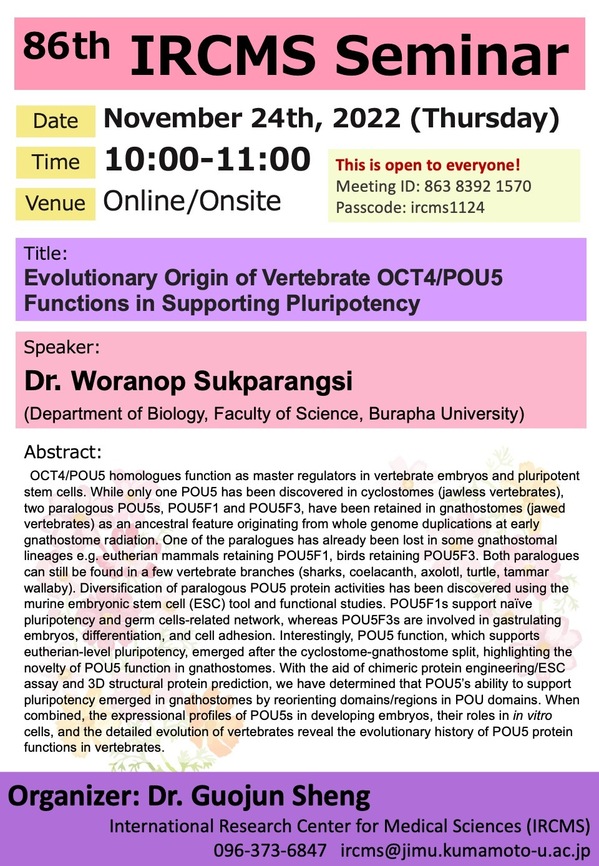- HOME
- IRCMS Seminars
- [ Nov. 24 ] 86th IRCMS Seminar
IRCMS Seminars
[ Nov. 24 ] 86th IRCMS Seminar
November 4 2022
We would like to inform you that the 86th IRCMS seminar has been scheduled as below.
* This IRCMS seminar is open to everyone.
Time and Date : November 24th, (Thu) 10:00 -11:00 (JST)
Venue : Zoom online
Meeting ID: 863 8392 1570
Passcode: ircms1124
Speaker : Dr. Woranop Sukparangsi (Department of Biology, Faculty of Science, Burapha University)
Title : Evolutionary Origin of Vertebrate OCT4/POU5
Functions in Supporting Pluripotency
Abstract:
OCT4/POU5 homologues function as master regulators in vertebrate embryos and pluripotent stem cells. While only one POU5 has been discovered in cyclostomes (jawless vertebrates), two paralogous POU5s, POU5F1 and POU5F3, have been retained in gnathostomes (jawed vertebrates) as an ancestral feature originating from whole genome duplications at early gnathostome radiation. One of the paralogues has already been lost in some gnathostomal lineages e.g. eutherian mammals retaining POU5F1, birds retaining POU5F3. Both paralogues can still be found in a few vertebrate branches (sharks, coelacanth, axolotl, turtle, tammar wallaby). Diversification of paralogous POU5 protein activities has been discovered using the murine embryonic stem cell (ESC) tool and functional studies. POU5F1s support naïve pluripotency and germ cells-related network, whereas POU5F3s are involved in gastrulating embryos, differentiation, and cell adhesion. Interestingly, POU5 function, which supports eutherian-level pluripotency, emerged after the cyclostome-gnathostome split, highlighting the novelty of POU5 function in gnathostomes. With the aid of chimeric protein engineering/ESC assay and 3D structural protein prediction, we have determined that POU5's ability to support pluripotency emerged in gnathostomes by reorienting domains/regions in POU domains. When combined, the expressional profiles of POU5s in developing embryos, their roles in in vitro cells, and the detailed evolution of vertebrates reveal the evolutionary history of POU5 protein functions in vertebrates.
References
Sukparangsi W, Morganti E, Lowndes M, Mayeur H, Weisser M, Hammachi F, Peradziryi H, Roske F, Hölzenspies J, Livigni A, Godard
BG, Sugahara F, Kuratani S, Montoya G, Frankenberg SR, Mazan S, Brickman JM. Evolutionary origin of vertebrate
OCT4/POU5 functions in supporting pluripotency. Nat Commun. 2022 Sep 21;13(1):5537.
doi: 10.1038/s41467-022-32481-z.
Livigni A, Peradziryi H, Sharov AA, Chia G, Hammachi F, Migueles RP, Sukparangsi W, Pernagallo S, Bradley M, Nichols J, Ko MSH,
Brickman JM. A conserved Oct4/POUV-dependent network links adhesion and migration to progenitor maintenance. Curr
Biol. 2013 Nov 18;23(22):2233-2244. doi: 10.1016/j.cub.2013.09.048. Epub 2013 Nov 7.
Morrison GM, Brickman JM. Conserved roles for Oct4 homologues in maintaining multipotency during early vertebrate development.
Development. 2006 May;133(10):2011-22. doi: 10.1242/dev.02362.

